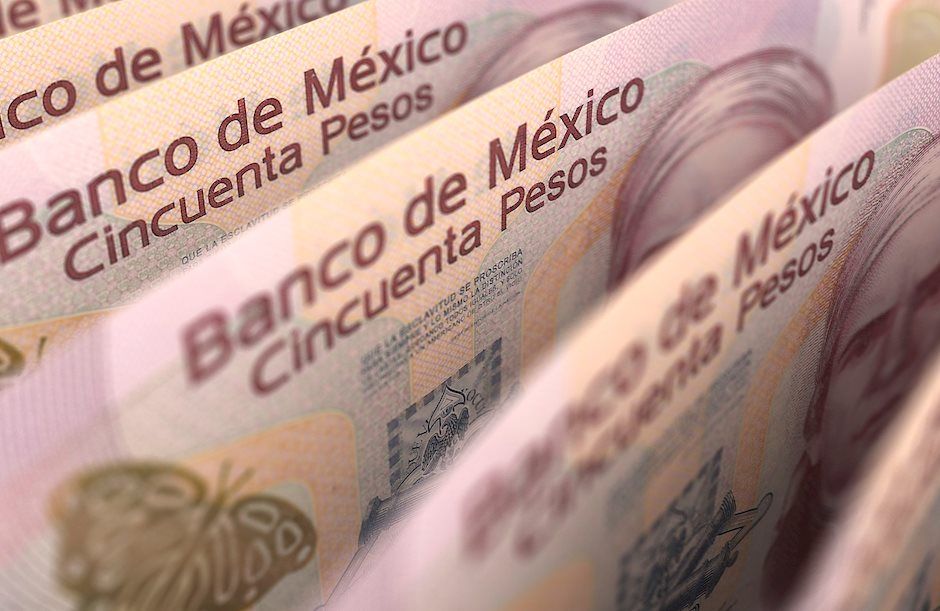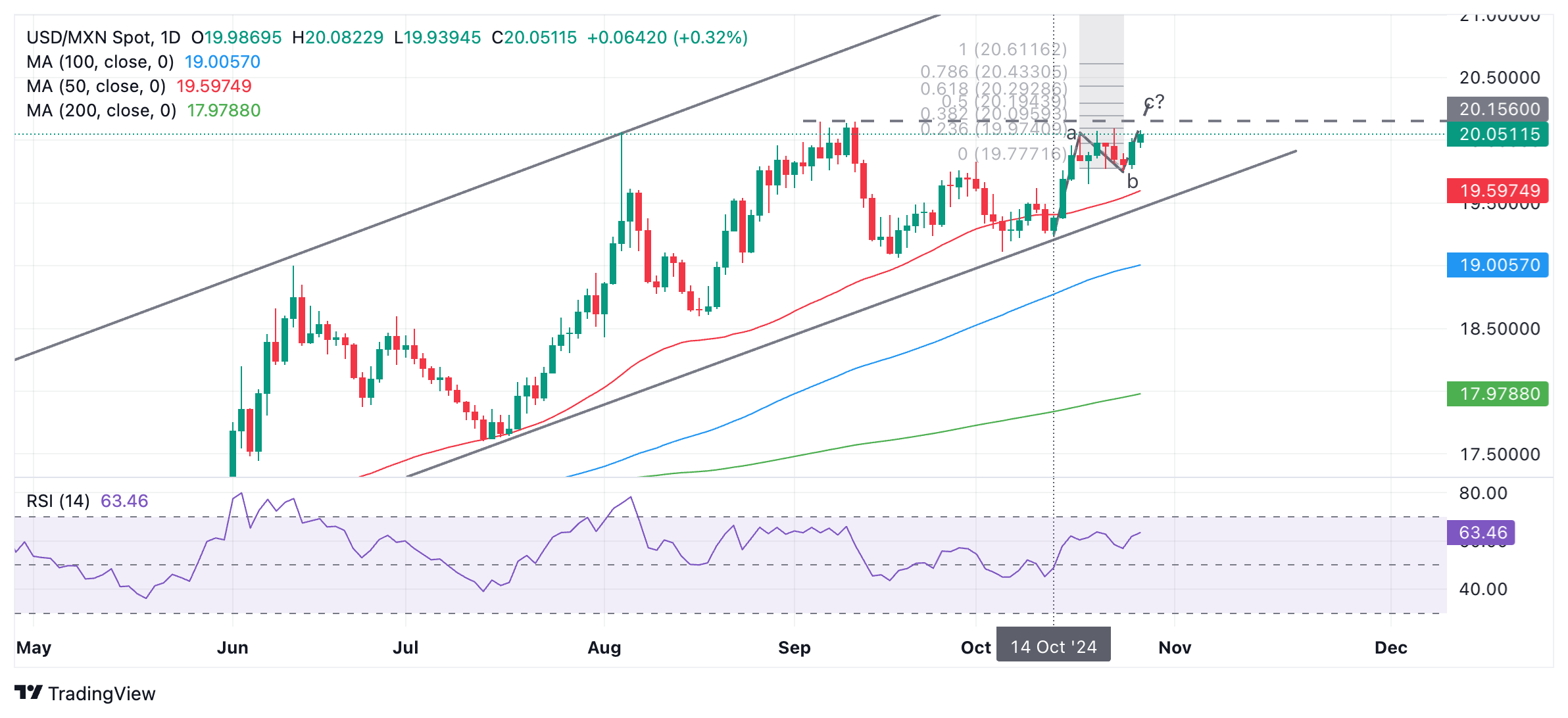Created
: 2024.10.28













![]() 2024.10.28 19:48
2024.10.28 19:48
The Mexican Peso (MXN) edges lower in its most heavily-traded pairs on Monday, extending the weakness witnessed on Friday. The US election risk is a growing factor for the Peso as polls show a very tight race for the White House. A victory for Republican nominee Donald Trump would be negative for the Peso due to his tough talk on tariffs on Mexican imports. Further weakness may be due to Mexican domestic political risk as the government seeks to impose judicial reform, making judges electable and limiting the judiciary's influence in constraining the legislature.
Recent below-par macroeconomic data from Mexico has not helped the MXN. Economic Activity and Retail Sales missed expectations in August, and core annualized half-month inflation showed a further decline in October. This suggests a greater chance the Bank of Mexico (Banxico) will cut interest rates by 25 basis points (bps) (0.25%) at its meeting in November.
Inflows from the carry trade, however, may counterweight negative factors as the Japanese Yen (JPY) weakens due to the ruling Liberal Democratic Party (LDP) party losing its majority in elections over the weekend.
The Mexican Peso is facing considerable risk from the increasingly ambiguous outcome of the US presidential election on November 5.
When Trump won the 2016 election, the Mexican Peso depreciated substantially, with USD/MXN rising from 18.60 Mexican Pesos per US Dollar (USD) to 20.90 after the result. The exchange rate rose even higher, to almost 22.00 after Trump took office in January 2017, according to El Financiero.
Trump now has a slightly higher 52% chance of winning compared to Vice President Kamala Harris' 48%, according to the statistical model of leading US election website FiveThirtyEight, even though the Democratic nominee is still marginally ahead in the polls. The inconsistency is because of the electoral college system and the greater weight that a few key swing states have in deciding the outcome.
The risk to the Mexican Peso from a Trump re-election mainly stems from his championing of putting tariffs on foreign imports. However, an estimated 15% of all US imports now come from Mexico, and their supply chains are so intertwined that it may be difficult to impose such sanctions in reality.
Product eco-systems across North America (NA) are now deeply integrated as a result of the 1994 NAFTA free trade agreement and the more recent USMCA accord. Most imports are now composed of parts from all three countries, which would make it difficult for Trump to actually tariff them without also harming the US economy.
"You really can't talk about a US-made car or a Canadian-made car or a Mexican-made car. These autos are really North American (NA)," says David Eaton, Director for Business Development at CPKC Mexico. "The car's parts and components cross the border 1000s of times before a car is made," he says in an interview with Bloomberg News' David Westin.
"USMCA says that 70% or 75% of the content or value of a car must meet with NA content requirements to get duty free treatment," continues Eaton.
Instead of buying rolled steel from Brazil, auto manufacturers in Mexico now make steel using Iron Ore from the US in order to comply with USMCA requirements. If Trump rips up the agreement, he won't only be damaging Mexico but also inflicting a wound on the US.
Many US companies already have huge factories based in Mexico, producing finished products using raw materials or parts made in the US or Canada. The toy manufacturer Mattel, for example, which owns the Barbie brand, makes most of its toys in Mexico using resin brought in from the US Gulf Coast, according to Westin.
As such, the risk from tariffs may not, in reality, materially affect Mexican-US trade as much as feared, leading to more modest depreciation for the Peso.
USD/MXN appears to have begun a fresh leg higher after a mild pullback. This leg is probably the "c wave" of a bullish "abc" pattern, which began life at the October 14 swing low. This wave will probably reach the Fibonacci 61.8% of the length of wave a, giving an upside target of 20.29. Such a move would gain confirmation from a break above the high of wave b at 20.09.

USD/MXN is also probably in an uptrend on a short, medium and long-term basis and is trading in a rising channel. Given the technical dictum "the trend is your friend," the odds favor a continuation higher.
In addition, the original break above 19.83 (October 1 high) has already confirmed a probable move up, with a target in the vicinity of the September 10 high at 20.13.
The Mexican Peso (MXN) is the most traded currency among its Latin American peers. Its value is broadly determined by the performance of the Mexican economy, the country's central bank's policy, the amount of foreign investment in the country and even the levels of remittances sent by Mexicans who live abroad, particularly in the United States. Geopolitical trends can also move MXN: for example, the process of nearshoring - or the decision by some firms to relocate manufacturing capacity and supply chains closer to their home countries - is also seen as a catalyst for the Mexican currency as the country is considered a key manufacturing hub in the American continent. Another catalyst for MXN is Oil prices as Mexico is a key exporter of the commodity.
The main objective of Mexico's central bank, also known as Banxico, is to maintain inflation at low and stable levels (at or close to its target of 3%, the midpoint in a tolerance band of between 2% and 4%). To this end, the bank sets an appropriate level of interest rates. When inflation is too high, Banxico will attempt to tame it by raising interest rates, making it more expensive for households and businesses to borrow money, thus cooling demand and the overall economy. Higher interest rates are generally positive for the Mexican Peso (MXN) as they lead to higher yields, making the country a more attractive place for investors. On the contrary, lower interest rates tend to weaken MXN.
Macroeconomic data releases are key to assess the state of the economy and can have an impact on the Mexican Peso (MXN) valuation. A strong Mexican economy, based on high economic growth, low unemployment and high confidence is good for MXN. Not only does it attract more foreign investment but it may encourage the Bank of Mexico (Banxico) to increase interest rates, particularly if this strength comes together with elevated inflation. However, if economic data is weak, MXN is likely to depreciate.
As an emerging-market currency, the Mexican Peso (MXN) tends to strive during risk-on periods, or when investors perceive that broader market risks are low and thus are eager to engage with investments that carry a higher risk. Conversely, MXN tends to weaken at times of market turbulence or economic uncertainty as investors tend to sell higher-risk assets and flee to the more-stable safe havens.
![]()
Created
: 2024.10.28
![]()
Last updated
: 2024.10.28

FXStreet is a forex information website, delivering market analysis and news articles 24/7.
It features a number of articles contributed by well-known analysts, in addition to the ones by its editorial team.
Founded in 2000 by Francesc Riverola, a Spanish economist, it has grown to become a world-renowned information website.
We hope you find this article useful. Any comments or suggestions will be greatly appreciated.
We are also looking for writers with extensive experience in forex and crypto to join us.
please contact us at [email protected].
Disclaimer:
All information and content provided on this website is provided for informational purposes only and is not intended to solicit any investment. Although all efforts are made in order to ensure that the information is correct, no guarantee is provided for the accuracy of any content on this website. Any decision made shall be the responsibility of the investor and Myforex does not take any responsibility whatsoever regarding the use of any information provided herein.
The content provided on this website belongs to Myforex and, where stated, the relevant licensors. All rights are reserved by Myforex and the relevant licensors, and no content of this website, whether in full or in part, shall be copied or displayed elsewhere without the explicit written permission of the relevant copyright holder. If you wish to use any part of the content provided on this website, please ensure that you contact Myforex.
Myforex uses cookies to improve the convenience and functionality of this website. This website may include cookies not only by us but also by third parties (advertisers, log analysts, etc.) for the purpose of tracking the activities of users. Cookie policy